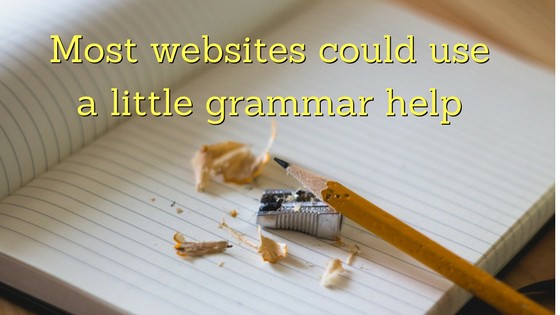Grammar Help For Online Publishers & Website Owners
You know how to do keyword research, you have great original art and graphics, and your design is both gorgeous and SEO friendly. Nice. But, your time-on-site (or session duration) still isn’t very good and you fear it’s hurting your Google results. What’s wrong? You may need grammar help.

The problem could be a simple one: you’re paying too darn much attention to the search engines and too little attention to the actual people who come to your site and read your content. You know, actual humans. They not only want good topics, but expect good grammar and engaging writing too.
In this article, I’m going to dig into how to produce engaging writing that keeps your readers on-page and offer up some basic grammar help too. Because it turns out that well written is important. Don’t believe me? Hit up some of those fly-by-night websites and try to actually read the weird, stilted and typically “spun” articles they’re using just for SEO.
Side note: Article spinning is when you programmatically replace synonyms so that one article can be “different” on multiple different websites. Good for robots, bad for humans.
Grammar is really important… seriously
In a previous article about reading score, and how it impacts SEO, we talked about spelling but let’s briefly go there again.

First up, please take the time to ensure that you use the right homonyms. If you don’t know the difference between “their” and “there” or between “insure” and “ensure”, find someone who does and ask them to proofread your copy before it’s published.
One of my pet peeves is the inability for writers to differentiate between “its” and “it’s”. Handy tip: the apostrophes should always be replaceable with “it is”. With that in mind, which one’s right: “Its a nice day” or “It’s a nice day”? For that matter, do you “pour” over a spreadsheet, or “pore” over it? And a cereal killer is quite different to a serial killer!
You’d be surprised at the amount of people that bounce once they start seeing some of these basic errors.
Read more about writing posts that keep people on your site longer here.
Why a lot of sites need grammar help
Remember those hated writing assignments where you had to diagram sentences? No, you don’t have to do that with your web writing, but it turns out that being able to assemble grammatically correct sentences is critical to your online success. If you can’t match verb tense, for example, it could have gotten weird.
Confusing, isn’t it?

I’m not going to offer a complete course on grammar, but the basics are worthy of your attention: stick to a tense (past, present, or future), stay with singular or plural references, use active rather than passive phrasing, and keep a consistent voice. Let’s look at a small sample to see what I’m talking about:
“After three weeks, Columbus and his crew made it to the Sargasso Sea. They undoubtedly missed both Spain and the Canary Islands by that point, but weren’t even half-way through their journey to the New World.”
This snippet demonstrates past tense, second person writing. The group of Columbus and the crew is referred to as plural in the second sentence: “They”. It reads easily and with its (not “it’s”) simple, short sentences, piques (not “picks”) your interest about what happens next.
If you’re concerned about grammar, write your blog posts, articles, stories or other content in a proper word processor like Microsoft Word or use the chrome extension Grammarly. These tools are not as good as a pro writer, but it’s still definitely better than just hoping you avoided making dumb or embarrassing mistakes.

Creating readable prose
Good grammar, proper spelling, smart page design, short sentences and short paragraphs are all important, but they’re icing. The core of any good content on the web is good writing. That’s the cake, and if you want to increase your time-on-page and close rate, that’s what you have to focus upon.
Keep in mind that all content, all articles, books and even blog posts tell a story. Imagine you are reading your prose out loud to an engaged audience: would they listen and be engaged and excited about what you’re sharing?
One great way to learn more about storytelling is to read books to young children. Children’s books tend to be reduced to the most essential aspects of storytelling and so are worthy of study. But don’t panic, I’m not saying you need to start all your white papers with “Once upon a time”, but it would be an interesting exercise for you to imagine how to tell your story in that vein.
For example…
“Once upon a time, there were Web publishers who wanted to improve revenue, time on page and related measures by changing the design of their pages. But they didn’t know how to test things! So a company named Ezoic came along and created a robot that could pull a Web page apart and reassemble it in any of hundreds of different ways. Better yet, that same robot could also then measure how people used that content, so it would figure out which layouts were the winners!”
See how that works? Now, what about your content? What’s the story of your product or service, and how well are you conveying it in your prose?


Hello to all
In this baffling time, I love you all
Rise your family and friends